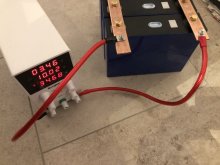Hedges
I See Electromagnetic Fields!
- Joined
- Mar 28, 2020
- Messages
- 20,976
Probably series resistance.
You've got 3.65V at some point in the power supply. (less at the supply terminals? check with a meter.)
Skinny leads and alligator clips. Less at he battery terminal. check with a meter.
Try measuring just voltage drop between an alligator clip and the aluminum terminal of the cell. taking 3.xx volts out of what's being measured, you may get millivolt or lower resolution reading of the voltage drop.
You've got 3.65V at some point in the power supply. (less at the supply terminals? check with a meter.)
Skinny leads and alligator clips. Less at he battery terminal. check with a meter.
Try measuring just voltage drop between an alligator clip and the aluminum terminal of the cell. taking 3.xx volts out of what's being measured, you may get millivolt or lower resolution reading of the voltage drop.



